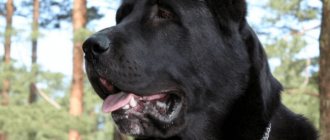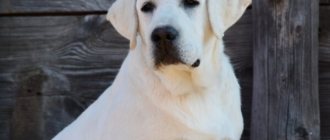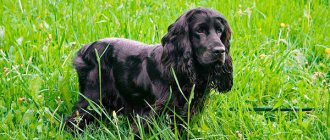Labrador is a special dog. This is a cheerful, kind and sociable dog. This breed first appeared in England at the beginning of the 19th century, although the first mention of such dogs dates back to 1300.
They originated from diving dogs that lived in Newfoundland at that time.
Labradors immediately began to gain popularity. Their noble figure and blue-black color (which was initially considered the breed standard) found a response in the hearts of English aristocrats.
Nowadays, Labradors are increasingly being adopted by families with small children, because... The retriever is one of those breeds that gets along well with children.
History of appearance and what it looks like in the photo
Initially, the chocolate Labrador was considered a breeding match. Such puppies were sent to some farms, awarded the title of “outcast” and not allowed to participate in breeding in order to eradicate the “brown gene”.
This is how things were for almost a hundred years.
However, gradually the brown Labrador received the right to full recognition . This color began to be recognized as a “classic of the breed” along with black and golden just a few years ago.
But perhaps this is due to the fact that a new “outcast” has appeared?
Recently, there have been frequent cases of Labradors being born with a silver coat color (charcoal, asphalt and other shades of gray) and they are not yet treated in the best way, considering them a defect, as they once considered chocolate ones .
Compatibility with other creatures
Naturally, before getting a new animal, you should make sure that it will be compatible with other pets that live in your home. Chocolate Labradors, as mentioned above, love absolutely everyone, so there are absolutely no problems with cohabitation on their part. They get along well with both dogs and cats, as well as with any other animals. As for children, Labradors always find a common language with them. In some cases, they not only do not harm babies, but also help them, becoming a full-fledged analogue of a nanny. So if you want to get an animal that can live in the same room with absolutely all living creatures, including adults, children and babies, then a chocolate Labrador will be the ideal option for you.
Brown coat color - defect or breed
Initially, only dogs of black color were considered purebred Labradors, because... This is exactly the color dogs had when they were brought to England. Gradually we got used to the golden ones, which began to appear in litters more and more often.
Chocolate babies have been persecuted for almost a hundred years.
But they were able to defend their “place in the sun” and now act as the same representatives of classic Labrador colors.
Types of Retrievers
The retriever group includes six different breeds:
- Labrador Retriever
- Golden retriever
- Flat-Coated Retriever
- Curly coated retriever
- Nova Scotia Retriever
- Chesapeake Bay Retriever
Chesapeake Bay Retriever
Golden retriever
Curly coated retriever
Labrador Retriever
Nova Scotia Retriever
Flat-Coated Retriever
These are all hunting dogs that were bred so that they could find prey and bring it to the hunter. Primarily waterfowl. They are all similar, but, nevertheless, they are different breeds.
Character traits
A common misconception: the color of the dog determines its character. Chocolate or black - the dog was and remains a bearer of the characteristic features of the breed, which are not affected by color.
Retrievers are generally cheerful and sociable dogs..
They are ideal for families with small children, but are completely unsuitable for the role of a security guard, because... Labradors have never been used as a guard dog and the breed has not developed the necessary skills for this.
They're still bullies! They chew anything that is left unattended .
Special toys for dogs briefly capture her attention; she is more interested in what humans are interested in. Whether it’s the owner’s shoes or a child’s toys - if a person is interested in this, then the dog can too.
The Labrador is great for being a companion dog. Breeders write that these dogs love hiking, love to swim and just be in nature.
Accordingly, if a man is interested in hunting/fishing/hiking in the forest to pick mushrooms, he won’t find a better dog..
Communication with children is a separate issue. Labradors are kind to little people. They always try to be close to them, they can play for hours on end.
If something alarming happens to a child (he falls and cries, for example), the dog will run to look for his parents.
Differences from other Labradors
The first question that many people have is: “What is the difference between a chocolate Labrador and a golden or black Labrador?” Someone makes guesses, trying to find some confirmation for them, but you shouldn’t even try to get to the bottom of the truth, because there is simply no secret here. The chocolate Labrador differs from other Labradors only in color. Otherwise, this is exactly the same dog, so you are unlikely to find any differences in the health or character of the pet, and if you do, these will most likely be individual characteristics. Therefore, do not mislead yourself - it is better to start studying in more detail the information available about these dogs.
Advantages and disadvantages
The Labrador is the only breed that has webbed toes. Yes, just like a duck.
That's why these dogs are excellent swimmers . On the one hand, this is a plus. You can safely take your dog to the beach with you and not be afraid that the dog will get scared of the water and run away.
In addition, if you raise her in the right way, she, if necessary, can save the life of a drowning person.
On the other hand, love for water can be considered a minus, because... during walks, all the puddles will be yours. A four-legged friend simply will not be able to pass by the water and will definitely “bathe”, and this will entail a heap of dirt in the house upon his return.
A huge plus, of course, is an excellent relationship with children . You won't find a better dog sitter.
The breed has almost no disadvantages. At least those that cannot be corrected.
During the first months, puppies chew everything in their path . But with proper training, this craving for “chewing” will disappear.
Trustingness (friendliness) is a very controversial trait of the breed. On the one hand, it is good that the dog does not rush at anyone who enters its territory.
On the other hand, “gullibility” + “lack of security skills” = danger. And not for the dog (which is also possible), but for the owners.
Training
The breed lends itself very well to education and training. You need to start your education small - accustom the baby to his place, do not allow pranks (chewing slippers, furniture). Toys are purchased for the puppy to play with. The breed is well suited for beginner dog lovers, as it does not require any special training methods.
The dog's sharp mind, insight and desire to please its owner make it amenable to training. The Labrador is one of the ten smartest dogs in the world. Of course, education and training must be carried out using the method of motivation, rewards for success, without shouting and cruelty.
Dimensions, weight
Apart from color, chocolate retrievers are no different from their fellow breeders.
There are breed standards , which are listed in the table below :
| Girl | Boy | |
| Weight, kg) | 27-35 | 27-40 |
| Height (at withers) | 54-60 | 56-63 |
The description of appearance can be made as follows: head, smoothly tapering towards the muzzle .
The jaws are powerful, the teeth grow clearly in a row. The chest is powerful, the paws are stable, not short. The tail grows straight, without bending into a ring. A short-haired breed with a very dense undercoat that does not allow moisture to pass through.
The nose is often brown, but sometimes acquires a pinkish tint, which does not spoil the overall appearance.
Don't forget about the membranes between the fingers.
During puppyhood, the Labrador grows and develops very quickly.
By 10 months, growth stops . Over the same 10 months, the puppy becomes 8-10 times heavier and turns into a powerful, but graceful and dexterous dog.
Dossier
Adult height: females – 54-56 cm, males – 56-57 cm. Weight: females – 25-35 kg, males – 35-40 kg. Characteristic color: chocolate of all shades. Coat length: short. Life expectancy: 12-14 years. Advantages of the breed: friendliness, cheerfulness, high intelligence, activity, lack of aggression. Difficulties of the breed: with a lack of training, it damages furniture and things. Average price: 500-1500 US dollars, depending on the pedigree and regalia of the parents. Classification: medium breed, working, hunting, apartment, pet and companion.
Life expectancy and what diseases are they susceptible to?
Labradors live quite a long time, on average 10-13 years .
Considering that the dog’s undercoat is quite dense, it is not afraid of rain during a walk and is not susceptible to colds.
However, despite their external power, these beauties also have their “Achilles’ heels.”
CAREFULLY!
Retrievers are often susceptible to allergic reactions to food.
Interdigital dermatitis is also quite common.
Regarding vision, Labrador Retrievers can experience problems such as cataracts and retinal detachment. Both of these problems will cause your pet to lose his vision.
Dysplasia
of the elbow and knee joints, osteochondrosis are new diseases that Labradors have recently begun to suffer from .
Cases of chronic otitis media (ear problems) are not uncommon.
Considering that dogs are naturally fantastic swimmers, they need frequent contact with water. This is due to the fact that if the dog does not make forced marches in water over long distances (which, in principle, can be replaced by running), its metabolism will slow down.
This can lead to obesity and joint problems.
Fortunately, most diseases can be treated . Therefore, if you encounter any problem with your pet’s health, do not delay visiting the veterinarian.
Norwich Terrier
A small sized type of English hunting dog. The height of miniature dogs does not exceed 25 cm. Standard characteristics of the appearance of the Norwich Terrier:
- small head with erect triangular ears;
- dark brown oval eyes;
- powerful chest, lowered to the elbows;
- thick short limbs;
The dog is covered with thick, hard hair with undercoat. In the area of the muzzle, ears, hair is smooth and shortened.
The light brownish color of the dogs is uniform. Individuals should not have white spots, even small ones. To maintain a healthy and bright color, it is recommended to comb your pets with special trimming equipment.
Basic rules of care
Due to the fact that ear problems are not uncommon in this breed, caring for them should be as thorough as possible. Veterinarians recommend regularly checking the ears for the development of infections, as well as cleaning them.
coat
is water-repellent, so they practically do not need bathing with shampoo .
The standard four washes per year are enough. It is recommended to comb the coat at least a couple of times a week.
Despite the fact that dogs are not susceptible to digestive diseases, it is necessary to brush your dog’s teeth.
You need to get used to this procedure from puppyhood, and you need to clean it with a special paste, which is sold in pet stores..
Features and description of the color of a chocolate Labrador with blue eyes
The chocolate-colored Labrador is a large, muscular, strongly built animal with a wide head, small floppy ears and a powerful, strong neck.
Dog with blue eyes: beautiful breeds
According to its characteristics, this variety is a fit and fairly active dog that grows to medium size. But despite this, they look both light and swift. At the height of the withers, adult males reach 59 cm. Their weight varies from 25 to 35 kg.
The coat of dogs is short and hard with a developed undercoat. The Chocolate Labrador Retriever's eyes and nose are a chocolate shade rather than the standard black color. It is this feature that gives the dog an interesting and unusual appearance.
Sometimes there are representatives of the breed with a pink nose. But this feature does not spoil the dog at all, but on the contrary gives it an attractive appearance.
Chocolate Labradors are born with blue eyes, but over time they darken and turn brown. Very rarely the eye color is preserved.
Additional Information! A brown Labrador with blue eyes is a very rare occurrence. At the same time, the animal takes on a simply incredible appearance.
Chocolate retriever puppy
All shades of chocolate
Everyone should know that when deciding to buy a Labrador dog, a brown puppy can come in different shades of chocolate. This is explained by the fact that color is a set of dominant and recessive genes that regulate color intensity.
Currently there are the following shades:
- hepatic;
- light brown;
- chocolate;
- bitter chocolate.
To ensure a bright coat color, experts recommend giving your dog vitamins to stimulate pigmentation.
Popular nicknames for boys and girls
Having decided to buy a chocolate Labrador retriever, the question of the name arises.
Considering that the breed is distinguished by its peace-loving nature, complete lack of aggression and boundless love for all living things, the pet’s nickname should be soft and affectionate:
| Boy | Girl |
| Alf | Alta, Alpha |
| Bull, Ben, Benya | Betsy, Betty |
| Vlas, Veles | Velma, Wendy, Vlada |
| Dobby | Josie |
| Jean | Irma, Iskra |
| Inkar | Kayla, Cola, Cam |
| Kai, Cam | Lima, Lassie, Leah |
| Larry, Louis | Myra, Mary, Mila |
| Mani | Nessie, Nola, Noira |
| Nolik, Nike | Ola |
| Patrick, Peter | Sarah |
| Sam, Soul, Sunny | Tori, Tasya, Tyra |
| Floppy | Helga, Hope |
| Yarik, Janis | Emma |
Video
The video shows the rules for choosing a Labrador Retriever puppy. Filmed by the My Dog channel.
Was this article helpful?
Thank you for your opinion!
The article was useful. Please share the information with your friends.
Yes
No
X
Please write what is wrong and leave recommendations on the article
Cancel reply
Rate the benefit of the article: Rate the author ( 1 vote(s), average: 5.00 out of 5)
Discuss the article:
How to choose?
To avoid being scammed by a buyer, there are a few things you need to know about retriever puppies.
A puppy at two months of age should weigh 6-8 kg . If the puppy weighs less, you can think about diseases that can affect the small body.
If the puppy weighs more, it means that he is not given the required amount of activity (perhaps he is not playing with the baby) or the child has problems with metabolism. Overfeeding also occurs, especially among novice breeders.
IMPORTANT!
The puppy should show a high level of interest in everyone who comes to him.
Do not forget that this dog is very friendly and active, so this requirement is justified.
It is better to buy a puppy from nurseries. For example, you can contact Iricon Dream. Firstly, the documents for the puppy will immediately indicate all the shortcomings, if any (underbite, short legs, etc.).
Secondly, a competent breeder accompanies the owner during training: advises, prompts, and can come at the owner’s request.
Thirdly, the puppy is taken from the kennel with age-related vaccinations already completed. And, of course, the risk of buying a mestizo is completely eliminated.
Labradors are wonderful dogs that can become part of the family . Their kindness and openness will not leave anyone indifferent.
Border Terrier
The Border Terrier is the smallest hunting species. The height of an adult dog reaches 38 cm at the withers. The small stature of this “hunter” is compensated by other useful appearance features. The body of the terrier is quite narrow, and the limbs are longer than proportional to their size. The hair is tough: it helps the owner protect himself from insects.
In purebred individuals, there are only three types of color. The most common color among them is light brown with hints of gray or darker areas of the coat. On the dog's muzzle there is brown hair that resembles a mustache and beard.
How much does a puppy cost?
A puppy with documents and pedigree, as a rule, costs between 25-30 thousand rubles. A dog without documents can be bought cheaper, but there is no guarantee that an adult will have all the characteristics of the breed.
Litter from exhibition champions costs 20 thousand rubles more. Puppies from titled parents can also be taken to various exhibitions.











